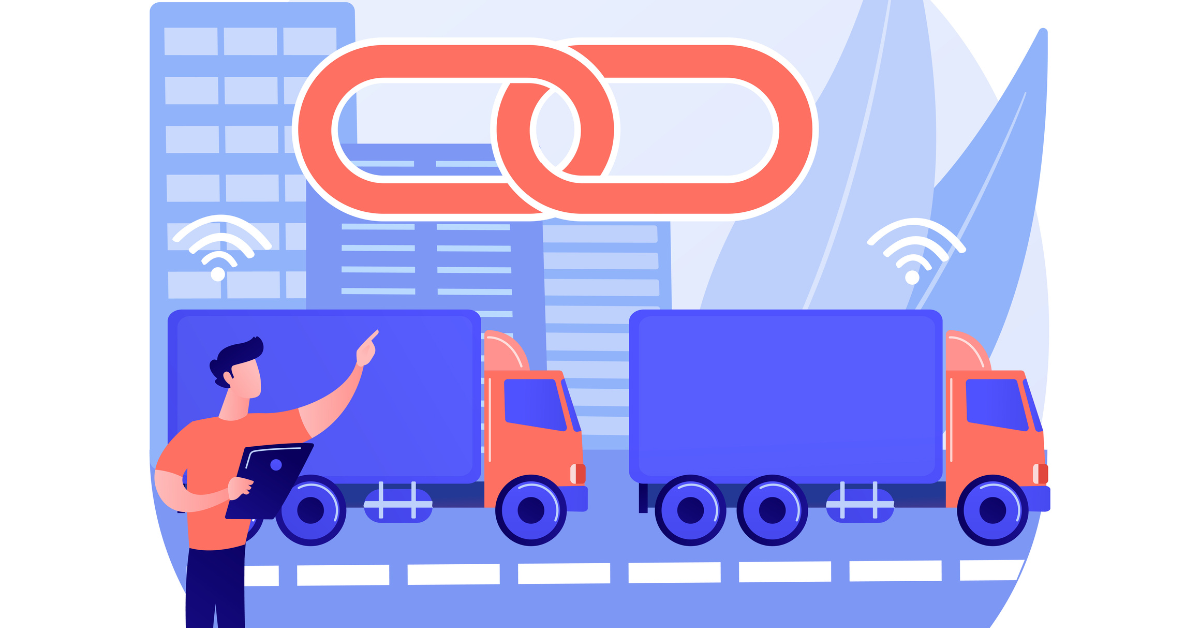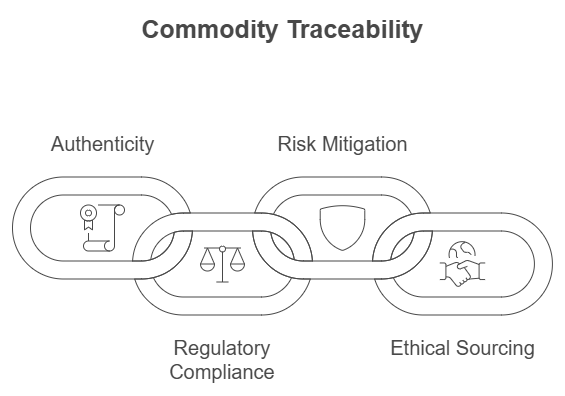Contact: +91 99725 24322 |
Menu
Menu
Quick summary: Discover how commodity traceability ensures product integrity, improves food safety, and provides competitive advantages for agribusinesses. Learn the importance of transparency in the supply chain.

Consumers in the global food market today, are more focused on the origins of their food and the journey it takes to reach their tables. Commodity traceability plays a crucial role for businesses where consumers can track the journey of every product, ensuring it meets safety, quality, and ethical standards. However, without proper traceability systems in place, food safety, sustainability, and compliance can be compromised—leading to risks like contamination, fraud, and inefficiency.
As agribusinesses scale and supply chains become more complex, ensuring the integrity of products from farm to fork has become more challenging—and more important—than ever. The key to meeting these demands and ensuring product integrity lies in commodity traceability. But what exactly does this mean, and how does it benefit both businesses and consumers? Let’s dive into how commodity traceability is revolutionizing the food industry and building trust in every bite.
Key Takeaways
At its core, commodity traceability refers to the process of tracking and documenting the movement of raw materials, or commodities, as they pass through the various stages of the supply chain. This could include everything from sourcing and processing to packaging and transportation. The goal is to ensure that every link in the supply chain can be traced back to its origin, ensuring transparency, compliance with regulations, and verification of ethical practices. In this context, commodity traceability aids supply chain traceability focusing on maintaining visibility across every touchpoint, improving efficiency and accountability in the overall system.
For example, imagine you’re buying a bag of coffee beans. With commodity traceability, you could trace those beans back to the specific farm they were grown on, the methods used to harvest and process them, and how they were transported to the roaster. This process helps ensure that consumers are getting what they paid for—whether that’s sustainable, organic, or ethically sourced products.
As the global food system faces numerous challenges, from fraud and contamination to supply chain disruptions and environmental impact, commodity traceability is proving to be a crucial tool in ensuring product integrity.
Consumers today are more informed and more concerned about the products they consume. They want to know that the food on their plates is safe, ethically sourced, and produced in a way that doesn’t harm the environment. Commodity traceability helps build consumer confidence by providing verifiable information about product origins.
Product traceability ensures that products meet the highest standards of quality, safety, and sustainability, businesses can differentiate themselves in the marketplace, attracting a loyal customer base.
Food safety is a top priority for both regulators and consumers. Traceability helps prevent the spread of contamination by enabling businesses to trace and isolate affected products quickly. In the event of a foodborne illness outbreak, material traceability can pinpoint where the issue originated, who was affected, and how to prevent further spread.
In cases of product recalls, having robust traceability systems in place can minimize harm and ensure that contaminated goods are swiftly removed from store shelves. This is especially important in industries like dairy, meat, and fresh produce, where safety standards are critical.
Governments around the world are implementing increasingly stringent food safety and sustainability regulations. From the EU’s Green Deal to the US Food Safety Modernization Act, compliance has become more complicated, with businesses facing penalties for failing to meet required standards.
Commodity traceability allows businesses to stay on top of these regulations by ensuring that every product in the supply chain meets the required criteria. This includes certifications like organic or fair-trade, and sustainable sourcing practices such as deforestation-free supply chains.
Fraudulent activities such as food mislabelling or counterfeiting have significant economic, ethical, and health-related implications. In recent years, consumers have been exposed to products that were falsely marketed as organic, fair-trade, or free from harmful chemicals. Commodity traceability helps combat this by offering a secure, verifiable system that ensures the authenticity of products.
Using technologies like blockchain, businesses can create immutable records that are difficult to alter, ensuring that each step in the supply chain is verifiable. This ensures that the claims made by producers are accurate, preventing fraud and maintaining consumer trust.
TraceX’s blockchain-based seed traceability solution transformed agriculture in a state government in India by enhancing supply chain transparency. This solution ensured farmers received authentic seeds, leading to better crop yields and promoting sustainable farming practices. By providing end-to-end traceability, it addressed issues of seed quality and fraud, fostering accountability across the entire supply chain.
Sustainability is another area where commodity traceability plays a pivotal role. As businesses and consumers push for a more sustainable future, it’s essential to know where products come from and how they’re produced. Commodity traceability systems can track the environmental footprint of raw materials, ensuring that sustainable practices are followed from the farm all the way to the consumer.
For example, in sectors like palm oil or soy, where deforestation is a significant concern, traceability helps companies ensure that their products don’t contribute to environmental degradation. This is key for companies looking to align with the EU Deforestation Regulation (EUDR) and other global sustainability initiatives.

Now that we’ve covered why commodity traceability matters, let’s take a closer look at how it works. In practice, traceability involves a combination of technology, data collection, and collaboration across various stakeholders in the supply chain.
The first step in ensuring traceability is collecting data at every point in the supply chain. This includes information on supply chain provenance ie. about the product’s origin, how it was processed, and how it was transported. Whether it’s the harvesting of crops, the manufacturing of goods, or the transport of commodities, every detail must be recorded.
Businesses use a variety of methods to collect this data, such as digital records, barcodes, RFID tags, and sensors. Each piece of data is then linked to the commodity, allowing it to be traced through the supply chain.
One of the most innovative technologies driving traceability is blockchain. By creating a decentralized, tamper-proof ledger, blockchain ensures that data about products cannot be altered once it’s recorded. This means that consumers, regulators, and businesses can trust the information they receive about the product.
For example, when a product is scanned, the blockchain can show exactly where it came from, what steps it went through, and when it arrived at the next point in the supply chain. This transparency fosters trust among consumers and ensures accountability throughout the process.
With advanced technologies like IoT (Internet of Things), businesses can track commodities in real time, providing up-to-date information on where the product is in the supply chain. This is particularly important for perishable goods, where timing is critical to maintaining quality and safety.
Real-time tracking also helps businesses respond more quickly to disruptions, such as delays in transportation or weather-related issues, ensuring that products remain on schedule.
Commodity traceability is not just about collecting data within one organization—it requires collaboration between all stakeholders in the supply chain. This includes farmers, suppliers, manufacturers, logistics companies, retailers, and even consumers. Supplier mapping is a critical process that ensures full visibility of all entities within a supply chain.
The more connected the supply chain is, the more efficient the traceability system becomes. When everyone shares and updates the data, the product’s journey from farm to fork is seamless and transparent.
Agribusinesses face several challenges when implementing commodity traceability systems.
Blockchain traceability solutions address several challenges in the agribusiness supply chain by ensuring transparency, security, and accountability.
The Tracex Food Traceability Platform leverages blockchain technology to provide end-to-end visibility in the food supply chain. It enables businesses to track every step of the product journey from farm to fork, ensuring transparency, compliance with regulations, and food safety. Tracex’s platform automates data collection and integrates seamlessly with existing systems, allowing stakeholders to access real-time information. This reduces fraud, improves efficiency, enhances accountability, and simplifies regulatory reporting, all while building consumer trust and brand loyalty.
Commodity traceability plays a crucial role in ensuring that the integrity of products is maintained throughout the supply chain. By adopting traceability solutions, agribusinesses can enhance food safety, comply with regulations, and meet consumer demand for transparency. As more businesses recognize the benefits of traceability, those who invest in these solutions will gain a competitive advantage and foster long-term trust with their customers.
Commodity traceability tracks the journey of agricultural products from origin to final consumer, ensuring transparency, food safety, and regulatory compliance.
It provides transparency in sourcing, processing, and transportation, making it easier to trace any issues back to their source, minimizing risks and recalls.
Benefits include improved efficiency, cost savings, risk mitigation, and enhanced consumer trust through transparent and ethical sourcing practices.
